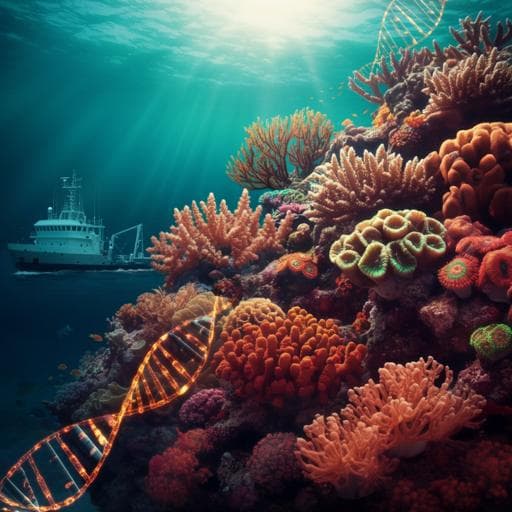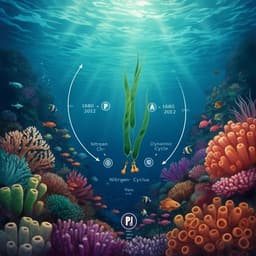
Biology
Heat tolerance varies considerably within a reef-building coral species on the Great Barrier Reef
M. S. Naugle, H. Denis, et al.
This study by Melissa S. Naugle, Hugo Denis, Véronique J. L. Mocellin, Patrick W. Laffy, Iva Popovic, Line K. Bay, and Emily J. Howells reveals fascinating insights into the heat tolerance of corals in the *Acropora hyacinthus* complex across the Great Barrier Reef. With a remarkable variation in thermal thresholds, the research highlights the influence of local adaptation and the potential for genomic variation in conservation efforts.
~3 min • Beginner • English
Introduction
Climate warming and marine heatwaves are causing widespread bleaching and mortality in reef-building corals, but heat tolerance varies widely among and within species. Intraspecific variation can be substantial and ecologically consequential, potentially rivaling interspecific differences, and may be augmented in species complexes through occasional hybridization. Understanding how heat tolerance is distributed within and among populations, and the factors that drive it, is essential for predicting persistence under climate change and for informing conservation, restoration, and selective breeding. The Acropora hyacinthus species complex is ecologically important yet highly vulnerable to warming, with cryptic diversity that complicates trait attribution. Symbiodiniaceae community composition can influence coral heat tolerance, but effects may be host- and taxa-specific. This study aims to quantify the distribution of heat tolerance at individual-to-reef scales across the Great Barrier Reef (GBR) in the A. hyacinthus complex, and evaluate contributions of environmental history, symbiont community, and host genomic identity to observed variation.
Literature Review
Prior work shows intraspecific variation in coral heat tolerance among reef populations and across fine-scale habitat gradients, often linked to environmental thermal history via local adaptation and/or acclimatization. Heat tolerance has been associated with historical thermal anomalies and temperature variability. However, broader ecosystem-scale mappings of within-species variation, and the relative roles of environment, host genomic identity, and symbiont communities, remain limited. The A. hyacinthus complex includes cryptic lineages differing in growth, microhabitat, and heat tolerance; unresolved taxonomy risks overestimating true intraspecific variability. Only a few studies (e.g., in American Samoa) have compared heat tolerance among putative species within this complex. Symbiodiniaceae identity can alter coral thermal tolerance, with GBR acroporids typically hosting Cladocopium and sometimes Durusdinium after bleaching, which can confer >1 °C tolerance increases. Yet, symbiont effects may be host-dependent and less apparent when variation is constrained within a single symbiont genus. Thus, disentangling environmental history, cryptic host lineages, and symbiont composition is critical to understand and leverage heat tolerance.
Methodology
Sampling and assays: 583 colonies of the Acropora hyacinthus complex were collected from 17 GBR reefs across 9.42° latitude (Jan 2021–Mar 2022); final experimental analyses included 569 colonies after excluding one assay run for poor temperature control. Colonies (>20 cm, visually healthy) were sampled primarily from reef crest/upper slope within a site, with metadata recorded (depth, GPS, CoralWatch score, photos). For each colony, 14 fragments were taken: 12 for the acute heat stress assay, 1 for genomic analysis, 1 for skeletal reference. A subset of 60 additional colonies at North Direction during a natural bleaching event (Mar 2021) was scored for color and genotyped for comparative bleaching sensitivity among putative species.
Acute heat stress protocol: A portable, vessel-based system (AIMS National Sea Simulator design) delivered four temperature treatments: local Maximum Monthly Mean (MMM) and MMM +3, +6, +9 °C (3 fragments per treatment). Assay profile: 3 h ramp-up to treatment, 3 h hold, 2 h ramp-down to MMM, overnight hold at MMM. Light was ~300 PAR with gradual dawn/dusk transitions. Temperatures were monitored with tank probes and independent loggers.
Trait measurements: Photochemical efficiency (Fv/Fm) was measured with imaging PAM 2 h after the ramp-down; three areas of interest per fragment were averaged. Color paling was measured as NDVI using hyperspectral imaging 10 h after ramp-down; three areas per fragment, median NDVI extracted via custom MATLAB script. NDVI was validated against total chlorophyll in a subset (fragment-level R=0.74, colony-level R=0.86). Some imaging data were missing for a small number of fragments; NDVI not collected for two early runs (Hicks n=20, Reef 21-550 n=15).
Heat tolerance metrics: For each colony and trait (Fv/Fm, NDVI), two metrics were computed: (1) Absolute ED50 (°C) from 3-parameter log-logistic dose-response curves (R drc; constraints: slope [10,120]; ED50 [28,40]; Fv/Fm [0,0.8]; NDVI [0,1]); estimates with CI >5 °C were excluded, retaining 83.7% (Fv/Fm) and 91.8% (NDVI). (2) Retained performance at MMM+9 °C as Trait(MMM+9)/Trait(MMM) adjusted for any temperature deviation: multiplied by ((Temp(MMM+9)−Temp(MMM))/9).
Genomics: DNA extracted (QIAGEN); whole-genome libraries (Lotus) sequenced (NovaSeq S4, 150 bp PE). Reads trimmed and mapped to A. hyacinthus genome; samples with <80% primary mapped reads excluded; technical replicates removed. 625 samples total had genomic data (565 assay, 60 natural bleaching). Mean 26.5M reads/sample; ~92.5% mapped; mean coverage 11.4x genome-wide (7.0x on 14 chromosomes). Population structure was inferred using ANGSD and PCAngsd: polymorphic sites filtered (mapQ>30, baseQ>30, coverage ≥3 in ≥95% individuals, biallelic, LRT p<1e-6, MAF≥0.05). PCA and Bayesian admixture (K=2–5) identified four host genomic clusters (putative species). Analyses of experimental heat tolerance among clusters focused on five southern sites to minimize latitudinal confounding.
Symbiodiniaceae: ITS2 rDNA profiled via amplicon sequencing and SymPortal. Reads normalized; sequences with <10 reads removed; 52 unique sequence variants retained; 12 ITS2-type profiles retained; low-read samples filtered (thresholds: 7500 reads for variants, 6100 for profiles), yielding 421 colonies with ITS2 variants and 424 with ITS2-type profiles. Community composition summarized by dominant ITS2-type profile and by PCA of ASV read counts. PERMANOVA (Bray–Curtis, 999 perms) tested effects of shelf position, latitude, host genomic cluster, and interactions.
Environmental data: 22 variables quantified thermal history (e.g., MMM, anomalies), recent heat stress (e.g., DHW), nutrient availability, light penetration, and in situ depth/pigmentation, derived from NOAA Coral Reef Watch (5 km, 1985–), eReefs hydrodynamic/biogeochemical models (1 km, 2014–; depth strata matched colony depth), and NASA MODIS.
Statistical analyses: Linear mixed-effects models (lme4) partitioned variance among vs within sites; a second iteration included host genomic cluster as an additional random effect. Boosted Regression Trees (gbm; learning rate 0.001, interaction depth 5, bag fraction 0.5, 10-fold CV) related predictors (environmental, Symbiodiniaceae PCs, host cluster) to each heat tolerance metric; variable influence and marginal effects examined; deviance explained computed via dismo gbm.step. Complementary linear models and stepwise regressions assessed predictor effects (Supplementary).
Key Findings
- Substantial individual variation: Across 569 colonies, ED50 thresholds differed by up to 3.5 °C for Fv/Fm (range 34.6–38.1 °C; mean 36.4 °C) and 7.3 °C for NDVI (range 32.4–39.7 °C; mean 35.6 °C). Retained performance averaged 0.39 (Fv/Fm; range 0.00–0.93) and 0.26 (NDVI; range 0.03–0.95).
- Spatial patterns: Highest ED50 performers were predominantly in northern reefs, with some top performers in central/southern reefs. Highest retained performance was generally in southern reefs, especially for Fv/Fm. Few colonies scored highly across both absolute and retained metrics, indicating trade-offs.
- Variance partitioning: For Fv/Fm ED50 and retained metrics, among-site variance exceeded within-site variance by 1.6–6×. For NDVI ED50 and retained metrics, within-site variance exceeded among-site variance by 1.3–1.5×, most pronounced for NDVI ED50.
- Trait correlations: Within-site rankings were consistent between absolute and retained metrics (Fv/Fm R≈0.71; NDVI R≈0.65). Cross-trait correlations were weaker (R≈0.36–0.47), reflecting different biological processes (photochemical impairment vs chlorophyll loss/bleaching).
- Host genomic clusters: Genome-wide SNPs resolved four distinct host genomic clusters (putative species); Group 1 (A. hyacinthus “neat”) comprised most samples (472/625). Clusters varied in spatial prevalence (Group 1 mainly central/north; Groups 2–4 mainly south and Fitzroy Island). After adjusting for site and restricting to five southern sites, heat tolerance metrics varied more within than among clusters; a non-significant trend toward lower NDVI ED50 in Group 2 was noted. During a natural bleaching event, Groups 2 and 3 had lower CoralWatch color scores (greater bleaching) than Group 4.
- Symbiodiniaceae: Communities were dominated by Cladocopium variants (≥99% reads), with rare Symbiodinium. ITS2 variants showed strong differentiation by shelf position (inshore vs mid/offshore) and latitude; dominant profiles varied accordingly. Despite spatial structuring, relationships between Symbiodiniaceae PC axes and heat tolerance were minimal overall (e.g., weak negative association with Fv/Fm ED50, R = −0.12, p = 0.026), with a few site-specific correlations.
- Predictors of heat tolerance (BRTs): Models explained 67.0% (Fv/Fm ED50), 80.6% (retained Fv/Fm), 35.9% (NDVI ED50), and 48.0% (retained NDVI) of deviance. Temperature variables were most influential across metrics. Higher MMM (>~28.5 °C) predicted higher ED50 for both traits. MMM was negatively related to retained performance (colonies on cooler reefs live further from their upper limits). Recent heat stress (DHW at collection >0.5) increased Fv/Fm ED50 and retained NDVI, indicating short-term acclimatization. Fewer historical anomalies were associated with higher retained performance in the south. Symbiodiniaceae variables appeared among top predictors only for NDVI metrics; host genomic cluster was not a top predictor in any model.
- Overall interpretation: Thermal history (climatology and recent heat stress) primarily drives variation in heat tolerance across the GBR, while within-reef variability is large and only weakly explained by measured environmental, symbiont, or host cluster factors, suggesting an important role for unmeasured functional genomic variation.
Discussion
The study demonstrates that the A. hyacinthus species complex harbors extensive heat tolerance variation from meters to >1,250 km scales. Thermal climatology (MMM) emerged as the dominant driver of absolute thermal thresholds, consistent with local adaptation to historical temperature regimes. Colonies from northern and inshore reefs had higher ED50s but lived closer to their upper thermal limits than southern counterparts. Recent mild-to-moderate heat exposure (DHW >0.5 and <4) increased heat tolerance in assays, indicating acclimatization effects that can transiently elevate performance but may be reversed or overwhelmed under severe stress. These findings underscore that both adaptation and acclimatization shape current heat tolerance.
Despite marked spatial structure in host genomic clusters and Symbiodiniaceae communities (especially across shelf position), these factors made limited contributions to explaining experimental heat tolerance, particularly when variation is constrained within Cladocopium. Within-reef variability, notably for NDVI ED50, exceeded among-reef variability, pointing to substantial fine-scale phenotypic variation likely underpinned by host and/or symbiont functional genomic differences not captured by the markers used. This high within-site variability implies that adaptive alleles are widespread and that even local scales may supply material for natural and assisted evolution.
For conservation and restoration, the divergence between absolute and retained performance metrics suggests different use-cases: absolute thresholds may guide selection of broodstock with high tolerance, whereas retained metrics inform population vulnerability relative to local climatology and potential persistence under warming. Southern populations, despite lower absolute thresholds, may be better positioned relative to their local environments and could benefit from gene flow of heat-adapted alleles from the north. Incorporating individual-level variation and multi-trait assessments into models and management will improve projections and the targeting of resilient individuals.
Conclusion
Heat tolerance within the A. hyacinthus species complex on the GBR varies widely both among and within reefs. Thermal history—particularly MMM and recent DHW—best explains among-site differences, while substantial within-site variation remains largely unexplained by measured environmental factors, Symbiodiniaceae community, or host genomic cluster, pointing to a role for unmeasured functional genomic variation. Multi-trait assessment revealed trade-offs and underscored the need to align metrics with management goals (e.g., absolute ED50 for breeding; retained performance for population resilience).
Future research should: (1) resolve taxonomy within the A. hyacinthus complex and explicitly account for species’ environmental preferences; (2) quantify functional genomic variation in hosts and Symbiodiniaceae beyond ITS2 to link genotype to heat tolerance; (3) standardize or explicitly model recent heat pre-exposure to separate acclimatization from heritable variation; (4) incorporate additional microhabitat variables (e.g., flow) and microbial associates (bacteria) that may affect tolerance; and (5) validate temporal consistency of acute assay rankings and their predictive value for field survival across seasons and events.
Limitations
- Pre-exposure effects: Recent heat stress (DHW at collection) influenced assay outcomes, potentially conflating acclimatization with inherited tolerance.
- Symbiont resolution: ITS2 markers have limited power to resolve closely related Symbiodiniaceae taxa and functional differences; intrageneric variation effects may be underestimated.
- Host genomics: Genome-wide clustering identified putative species but did not capture specific functional variants linked to heat tolerance; small sample sizes for non-target clusters limited power.
- Within-reef drivers: Unmeasured microhabitat variables (e.g., water flow) and fine-scale environmental heterogeneity were not fully captured and may contribute to within-site variability.
- Measurement timing: NDVI was measured later than Fv/Fm (10 h vs 2 h post-stress), potentially increasing variance and complicating cross-trait comparisons.
- Sampling imbalance: Spatial and cluster representation varied (e.g., more Group 1 in north/central; Groups 2–4 mainly south), which may introduce confounding despite analytical controls.
- Data gaps: Some imaging data were missing for select fragments/runs; one assay run excluded due to temperature control issues.
Related Publications
Explore these studies to deepen your understanding of the subject.







